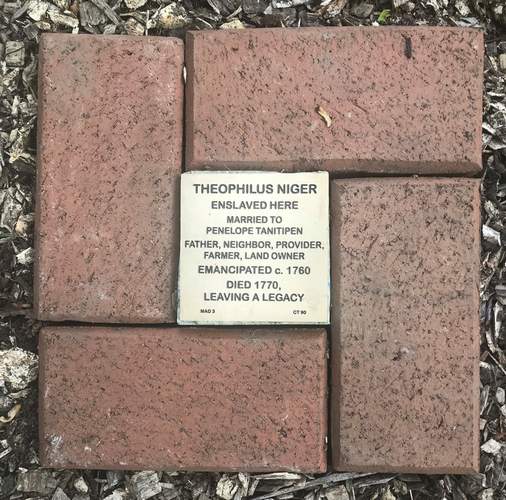Theophilus Niger: A Short History
A Biographical Sketch Written by Students at The Country Schoool
Editor’s Note: After spending weeks collectively researching documents, students worked individually to piece together a biographical narrative reflecting Theophilus Niger’s life story. What follows is a composite of their sketches. Like all histories, elements of this narrative are likely to change as more details emerge. Please reach out to us if you have something to add.
When you think of the first event in anyone’s life, you generally think of their date and place of birth. Unfortunately, with many enslaved people, those details were not recorded (or at least they are not a part of the archived records), and that is the case with Theophilus Niger. Likewise, we do not know whether he was born in Africa, the West Indies, or the New England colonies, nor do we know if Theophilus was the name his parents gave him at birth. (If he was born in Africa, he almost certainly had a different name at the start of his life.) All we know for sure, based on the records we explored, is that he was enslaved for much of his life by Thomas and Abigail Hodgkin, who lived in the house at the intersection of Horse Pond and Wildcat roads. The house, dated 1745, stands in the same spot today.
The first record in which we see him listed by name is on an earmark registration found in Guilford town records. At the time, earmarks were required to identify the ownership of livestock in communal grazing areas. Dated 1739-1740, the registration includes a drawing and description of an earmark, accompanied by the name “Theophilus negro.” Given that we have found no other Theophilus of African descent in the town, we assume this refers to Theophilus Niger. We found it interesting that someone who was enslaved had a registered earmark, because it suggests that he owned at least one animal. Finding the earmark registration was also helpful in establishing that he was in town in the late 1730s, a period when there were relatively few enslaved individuals of African descent in Connecticut. (Records show the population of enslaved Africans in Connecticut in 1740 was 2,600; it would nearly double by 1770.)
The next place we found him listed by name was in records for the First Congregational Church of East Guilford, showing the marriage of “Theophilus ___, negro” to “Penelopy [sic.] Tantipen” on April 14, 1748. The minister who officiated was Rev. Jonathan Todd, who some years later would become the enslaver of at least eight people, including Tamar and Lettuce Bailey, the mother and daughter who were researched by previous Country School 8th Graders. Church records do not say how old Theophilus Niger and Penelope Tantipen were at the time of their marriage. A few students researched the average age of marriage for a man in the mid-1700s and discovered it was 28. Taking that average into consideration, we surmised that Theophilus Niger was likely born sometime around 1720, a date we have used (with a circa) for his marker.
A few things to consider about the Niger-Tantipen marriage: We have found others living in the area who had the last name Tantipen, or something approximating it (spellings vary in the records), and they were all identified as Native American, some as Mohegan. For those reasons and others, we believe Penelope was Native American, and possibly Mohegan. We have found no evidence to suggest that she was ever enslaved, although some Indigenous individuals were, especially after the Pequot Wars. At the time, a law existed which held that the children would follow the condition of their mother. In other words, if the mother was enslaved, the children would be too. Because Penelope Tantipen appeared to be free, we believe the Niger children were as well.
We do not know for certain whether Theophilus Niger was enslaved by Thomas and Abigail Hodgkin at the time of his wedding. We do know that the Hodgkins built their house at the intersection of Horse Pond and Wildcat in 1745. If he was living with them in the years before his marriage, it would not be surprising if he assisted in the house’s construction. Woodworking tools were among the items listed in Theophilus Niger’s inventory after he died, so we can assume he was at least familiar with basic construction materials and methods.
Markings in the Hodgkin House – A Connection?
The notion that Theophilus Niger was handy with wood and tools is also interesting for another reason. In 2013, the Hodgkin house, now the home of Madison First Selectwoman Peggy Lyons and her family, was visited by an architectural historian who noted unusual markings on beams in the oldest part of the building. He described the markings as almost like “cardinal directions.” We Googled the term and saw something that looked like the face of a compass (or like a cross inside a circle). In other houses where enslaved people lived, including in Connecticut, symbols have been found carved on surfaces which might appear at first glance to look like the face of a compass. African art historians have identified those carvings as Bakongo cosmograms, symbols designed to allow connection with ancestors. The Lyons family kindly allowed a student to visit to see if she could find a marking that resembled a cosmogram. She didn’t (although there was a crawl space she wasn’t able to examine), but she did find other carvings on beams which resemble a backwards letter S, or perhaps a snake. One West African art expert told us that snakes have deep symbolic meaning in West and Central African belief systems. Is it possible that Theophilus Niger left a mark, perhaps in an attempt to connect with those who came before him and from whom he was separated not just by time but by an ocean?
Church records show that two years after their marriage, the Nigers’ first child, Philip, was born. He was followed by Phebe in 1752, Theophilus in 1755, Eliab in 1759, and William in 1760. They may also have had a daughter Ama, since her name appears in later documents, but we do not have an official birth year for her. Unfortunately, the same year William was born Penelope Tantipen died, and William died just a couple of weeks later. We wondered whether anything had occurred in 1760 that made the death of a mother and infant likely. One classmate discovered that in 1760, there was an outbreak of smallpox in Guilford, brought home by soldiers. She surmised that the disease may have killed both mother and child.
Throughout all this time and for at least a decade after his wife’s and son’s death, Theophilus Niger continued to be enslaved. We have found several documents indicating as much, including the first draft of Thomas Hodgkin’s will, written in 1751, in which he promised to leave two plots of land to “my negro man servant Theophilus.” At the time, “servant” was a euphemism for enslaved person; again, this language led to conversations about the mindsets of both the author and keeper of the record. Significantly, the will also promised his freedom after Mrs. Hodgkin died. Two years later, however, Thomas Hodgkin rewrote his will, taking one of the plots of land back and giving it to his nephew and neighbor, Jedediah Coe, instead. Interestingly, after Thomas Hodgkin’s death, Jedediah Coe gave Theophilus Niger a plot of land out of “consideration of the respect and goodwill I have for Theophilus, a man Negro and servant.” This action, and the language used and tone conveyed, made us wonder what might have occurred to make the nephew of his enslaver appear to be both respectful and generous.
Because we know from the Probate Court inventory after his death that Theophilus Niger left his children property and a house and barn, we believe that he and his family were able to live in their own house, perhaps even before he was freed. We also found a record from around the same time showing that Thomas Hodgkin’s widow, Abigail Hodgkin, joined Theophilus to sell land to Noah Scranton. We do not know why they would be selling land jointly and/or how it might connect to the gift from Jedediah Coe. However, the fact that he was owning and selling property as an enslaved person seemed significant and unusual, as did some of the language used to describe the exchanges. These developments led to lengthy classroom discussions about Theophilus Niger’s agency and his strength as an individual.
Abigail Hodgkin prepared her will on February 18, 1760, although she would not die for several more years. The will made no mention of freeing Theophilus. However, it did mention property she would be leaving him, and for the first time she did not identify him as a (or her) servant. Instead, she called him “Theophilus a negroe” [sic]. Could that mean he had been freed?
Finally, our question was answered. While searching land records late in the research process, we stumbled upon a record dated 1761. Filed in Guilford Town Hall property records under the last name Theophilus (which had made it difficult to find), four words jumped out at us. They were “Theophilus, a free negro.” These words appear in a document in which he purchases land from Phineas Meigs. Yet again, it is interesting to see that he is buying land, but what is far more important is that it confirms what we had hardly dared to hope: By 1761 he was free.
Sadly, less than 10 years later, Theophilus Niger was gone. We do not have an exact date for his death, but Probate Court records show that on July 17, 1770, Jedediah Coe was named administrator of his estate, so his death must have occurred sometime before then. If our estimate about his birth year is correct, he would have been about 50 years old. In one probate record he is called “Toffee Negro,” while in another we see him listed as “Theophilus Niger.” As we have said, Niger is the name his children and subsequent generations would continue to use, so it is the surname we have included on his memorial marker and in this book.
The Name Niger
Curious about the name Niger, we researched its origins. The name of the main river in West Africa, the West African country Niger, and the root of the name for Niger’s neighbor, Nigeria, “Niger” as a name apparently stems from a Tamasheq phrase, Gher n-gheren, meaning “River among rivers.” Tamasheq is a variety of a Tuareg language spoken by nomadic tribes in North and West Africa. Could the name “Niger” have been a tribute to Theophilus Niger’s ancestral homeland?
In addition to showing us his surname for the first time, the Probate Court records give us some important clues as to how Theophilus Niger made his living, besides buying and selling property. For instance, along with a house, barn, and significant acreage with multiple uses (fields, orchards, and forests), the inventory includes farm animals, farming equipment, woodworking tools, and fishing equipment. Could this mean he made his living as a farmer? That perhaps he built houses? That he and his family fished in Horse Pond or the nearby Long Island Sound? Numerous household items and furniture are listed, along with extensive articles of clothing. A book and fiddle may indicate how the family spent any leisure time.
The distribution of his estate, also reflected in Probate Court records, underscores the depth and breadth of Theophilus Niger’s holdings. Phillip received the house and barn with land surrounding it. Eliab and Theophilus Jr. also received expansive land holdings and they, too, would have houses. Phebe received valuable “sundry moveables” (household items), as did Ama. The fact that Theophilus Niger was able to leave so much to his children must have made a meaningful difference, both for them and for subsequent generations.
Identifying property and landscapes Theophilus Niger would have seen
Knowing that he spent most of his life near Horse Pond, one classmate set out to find the house where the Niger family lived. He examined 18th century property records, which describe neighbors, landmarks, and distances between them in units of measurement such as acres and rods. Overlaying the archived descriptions and measurements with a modern-day aerial map, he thinks he identified the Niger family home. Viewable from Horse Pond when the leaves are off the trees, the suspected house is located in the woods behind the Hodgkin/Lyons and the Coe houses. If his thesis is correct, students likely saw the house when they stood by the pond at the start of the project and it will be visible from the site of his marker on Horse Pond at certain times of the year.
After their father’s death, Phillip and Theophilus Jr. served in the Revolutionary War, fighting for our country’s freedom. Records show Theophilus Jr.’s service included protecting the coastline from the British. Phillip may have traveled farther afield. Later records show Theophilus working at least for a time in the shipping industry. Like their father, Phillip, Theophilus Jr., and Eliab were also involved in the buying and selling of real estate. According to land records in the Guilford Town Hall, in 1779, Phillip, now living in Branford, sold land that had been given to his father by Thomas Hodgkin. In 1802, Eliab, still living in town, sold property to Julius Wilcox. After his death in 1805, his land was sold to Daniel Hand. Meanwhile, Theophilus Jr. is on record as having sold his property near Horse Pond to Richard Hart from Saybrook in 1809. In 1810, he and his wife, Submit, also sold property they owned in Killingworth.
We found Phillip living into his late 80s in Montville, which, based on some of the other Tantipen records we saw, may have been where his mother’s family originated. We were not able to learn more about Phebe or Ama Niger. This may be because women often took on their husband’s names, making it difficult to locate them in archives.
Theophilus Jr. and Submit moved to Saybrook, where church records show they lived with several children, many of whom were baptized in the church. Two of those children, Alfred and William, later moved to Providence, Rhode Island, where they became barbers and small business owners. In Saybrook land records, there is a document showing Alfred and William sold the family property in Saybrook in the 1850s. Based on the description, the property appears to have been in or near what is now known as North Cove, between the Connecticut River and Long Island Sound, land which today would carry a hefty price tag.
Looking for the Nigers in Saybrook
Seeking any history they could connect to the Nigers in Saybrook, two 8th Graders walked around town, visiting the Cypress Cemetery. They came back empty-handed, although one of the gravestones in the cemetery they visited was for a woman named Rose Jackson, who was enslaved by General William Hart. General Hart’s son, Richard, was the man who purchased property near Horse Pond from Theophilus Jr.
While putting this book together, we learned from a researcher that, in a codicil in his will, General Hart gave Theophilus Jr. property near his home in Saybrook, provided General Hart’s sons could continue to traverse the land to access “the meadow.” The General William Hart House, located on Main Street in Old Saybrook, is on the National Register of Historic Places and is open for guided tours.
Alfred Niger would go on to become a prominent Black voting rights activist in Rhode Island, helping to lead the only successful antebellum effort in the country to restore the vote to Black men and serving as an agent for William Lloyd Garrison’s abolitionist newspaper, The Liberator. According to writer/historian C.J. Martin, Alfred Niger also served as a delegate to the New England Anti-Slavery Society, which helped lead him and others to establish the Rhode Island Anti-Slavery Society. Many articles have been written about Alfred Niger, and he even has a Wikipedia page devoted to his history as an activist from Rhode Island. In The “Mustard Seed”: Providence’s Alfred Niger, Antebellum Black Voting Rights Activist, Martin sums up Alfred Niger’s life and legacy this way:
Alfred Niger died on August 25, 1862, and his funeral was held a few days later at his home on 28 Spring Street. Niger helped lead the Black community in Providence to conduct the only pre-Civil War movement in the United States to regain the right of Black men to vote, a monumental achievement that has only been given passing glances by historical scholarship. With the proliferation of histories of the abolition of slavery, of leaders in Black communities all across the country, and of the Black freedom struggle in general, the life and achievements of Alfred Niger deserve our attention.
Alfred Niger and his wife, Julia Anne Bowen Niger, had several children, including Alexander Petion Niger, whom they presumably named for Alexandre Petion, the first president of the Republic of Haiti, “signaling, undoubtedly, the pride he took in his Blackness,” as Martin wrote. Like his father, Alexander Petion Niger also recorded some firsts, becoming the first Black printer in Providence and serving as a founding member of a typographical union there. This entry from the book Printers and printing in Providence, 1762-1907, highlights Alexander’s accomplishments (Alexander’s brother, Henry Niger, also a printer, is mentioned in the book as well):
ALEXANDER P. NIGER Died Providence Jan. 13, 1898, aged 68 years. He was the first man of color to work at printing in Providence and probably the first one to be admitted to any Typographical Union in the United States. His name appears in the Directory of 1850 as working at 15 Market square, where the Daily Post was printed. Later he worked at 24 Westminster street, A. Crawford Greene’s office. He was a charter member of Providence Union in 1857 and retained his membership until 1878, when the Union disbanded.
Alexander Niger built a successful business, ultimately amassing an estate that included a house near Brown University and property on Nantucket. While searching online records, students were excited to find photos of his house and his printing business.
So far we have not been able to find living descendants, but with or without stories of contemporary members of the family, it is easy to see the impact Theophilus Niger had on those who came after. As one classmate wrote in her biography, “Theophilus Niger left a legacy.” Speaking specifically about his grandson, Alfred Niger, she wrote that she imagines Theophilus would have taken “pride in his family and what they have accomplished” and that Alfred probably “thought about his grandfather,” who “wanted history to be different for his kids and his grandchildren. … He wanted Black people to vote and have the same rights as everyone else.”
For us, learning about Theophilus Niger and how he lived his life, was both inspiring and illuminating. That is an additional part of his rich legacy. We hope you agree.



